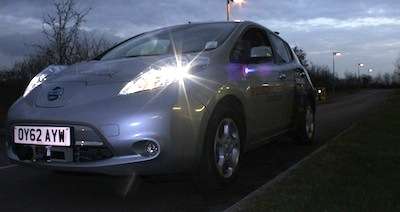February 15, 2013 report
UK's RobotCar demonstrated (w/ Video)

(Phys.org)—A group of scientists at Oxford University in the UK have demonstrated their version of the self-driving car, which promises to be much cheaper than similar cars being developed elsewhere.
The car, being developed by Oxford RobotCar UK, is designed to allow drivers to decide to let the car take over the driving when the car's computer makes the offer. A simple tap on the brakes at any time returns control immediately to the driver.
Unlike other autonomous vehicles being developed by groups such as Google, the UK team have concentrated on developing their technology using cheap components such as sensors to dramatically reduce the cost. At present, the system costs about £5000 (7750 USD), but the scientists hope to be able to reduce the cost to as little as £100 (about 150 USD)
The system consists of a modified Nissan LEAF electric car with an iPad mounted in easy reach of the driver, lasers attached to the front of the car, and stereo cameras that work with the lasers to produce a three-dimensional image of the route being taken. The lasers and cameras constantly map out the route being taken by the car.
The entire system is controlled by a Main Vehicle Computer (MVC) installed in the trunk, which can control virtually every aspect of the car. A third computer is the Low Level Controller (LLC), which communicates directly with the iPad user interface. The system does not depend on GPS.
The goal of the project is for the RobotCar to drive itself mainly on short journeys on routes with which it is familiar. During the initial period the RobotCar builds a 3D map of routes taken by the car, which is being driven normally. Once it has built up a memory bank of familiar routes it begins to offer to take over and the driver can accept by tapping on the iPad screen. If there is any conflict between the three on-board computers autonomous driving is not offered. If there are any problems during autonomous driving the iPad prompts the driver to resume control. If they do not, the car slows to a stop.
A laser under the front fender scans with an 85 degree field of view up to 50 metres ahead for obstacles such as pedestrians, other vehicles, or objects, and if the car is in control it automatically slows to a stop if an obstacle is detected. It accelerates and continues its journey only when the road ahead is clear.
The Oxford team, led by Professor Paul Newman, expects manufacturers will be fitting the system into their cars within 15 years or less. They say the autonomous vehicles will make the roads safer and less congested, and will be particularly useful for drivers following regular routes. Professor Newman said the cars of the future would be driving themselves some of the time rather than all of the time.
The RobotCar has been demonstrated on private roads around the Begbroke Science Park in Oxfordshire, but the group is in talks with Britain's Department of Transport to arrange for trials on public roads.
More information: mrg.robots.ox.ac.uk/robotcar/
© 2013 Phys.org




















